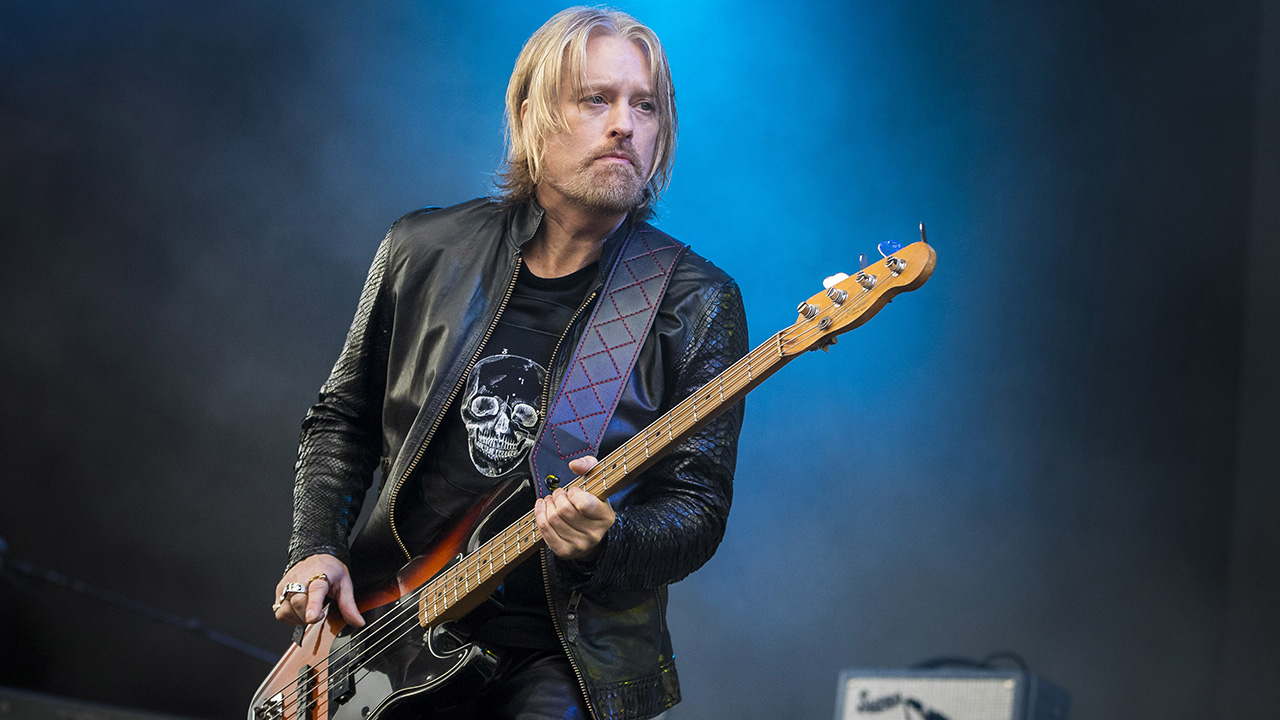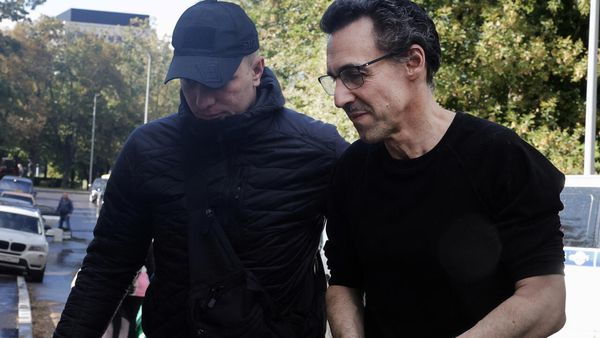
With the ability to create seemingly unending deep pockets filled with sub-hooks, Chris Wyse has landed gigs with Ozzy Osbourne, Ace Frehley, Tal Bachman, The Cult, and, most recently, the Hollywood Vampires, making for a hearty resume.
And while his climb to the top of the bass-playing mountain was long and hard, he felt he was destined to make it from the start. “I had a strong sense that I’d play music for a living, and I had an even stronger drive,” he tells Bass Player.
“So I made some recordings, which made their way to Mike Varney, who wrote some very nice things about me. He said I was one of the finest two-hand tappers he’d ever heard – which was amazing as I was only 17, and I’d been playing for just three years. It was like the gods had confirmed my intuition was right.”
Wyse’s chops landed him exposure in mags like Guitar Player when he was 17 and Guitar for the Practicing Musician when he was 20; but things didn’t really kick off until he made his way to L.A.
“As an up-and-coming player, the big thing was being able to lay down grooves and do so tastefully,” he says. “I did my best to dress songs up like a Christmas tree to where there was a theme.”
That ability to dress songs up has served Wyse well, while giving him the opportunity to play alongside some of rock and metal's finest – and it nearly scored him a spot in Metallica, leading to a well-known audition (more on that later).
These days, when he’s not working on his bass-centric solo work, Wyse is currently holding down the low end for the Hollywood Vampires, who wrapped up an extensive tour at the end of 2023.
Given that he's served under Ace Frehley, it’s no surprise he’s been able to lock in so well with Joe Perry. “With Joe and Ace, you just have to let them do what they do and lay down a solid, groovy, powerful and dynamic rhythm,” Wyse says.
“If you create that bed, they’ll layer all sorts of things over the top and create some real excitement. What they do isn’t precise – there’s some sloppiness – but they both know how to create a wide sound. It’s amazing to watch them do what they do; it’s unlike anyone else.”
Can you remember what first inspired you to pick up the bass?
“When I was young many of my friends played guitar and drums, and I was looking for my instrument. I wanted to play music – I was into a lot of hard rock bands – but I didn’t know what I wanted to play. I got into everything from The Beatles to Led Zeppelin to Rush, but that didn’t spark me to pick up the bass.
“My friends wanted me to play bass in their band, and around then I heard Iron Maiden’s The Number of the Beast. That was an eye-opener because Steve Harris showed me that the bass could be very diverse and almost athletic as an instrument. That’s how I found my instrument.”
Can you remember your first bass?
“It was a Gibson Ripper L-9S. It was honey-blonde colored. I regret getting rid of it to this day – it was such a cool bass, man!”
And how about your first proper bass rig?
“I remember getting an Ibanez Roadstar II bass with a maple neck. I liked it because it was closer to a Fender P-Bass, which I really wanted. I drove that Ibanez into the ground until the neck was unplayable and totally shot. That bass got me into tapping and soloing like Eddie Van Halen, who greatly influenced me.
“I also remember having a Kubicki Ex Factor bass with a Steinberger TransTrem bridge. I had all kinds of stuff, but the P-Bass is what I related to most. I found this guy with a ’54 Tele neck bass, and I put that neck on my ’95 P-Bass body and put a DiMarzio J pickup in there, along with a Quarter Pound T pickup. That’s been my number one since the ‘90s – makes it onto every record.”
Speaking of the ‘90s, can you remember recording Tal Bachman’s hit, She’s So High?
“I would have been using the ’54 Tele neck Frankenstein bass. Bob Rock loved the sound of that bass, and even though he had all sorts of bass guitars in the studio, that bass kept coming up because it just has this special thing. The neck has a lot to do with it, but maybe there's some kind of resonance in the wood, too – I don't know.
“Anyway, I remember Tal’s demos featured some different stuff, so I took some chances by playing some riffs more melodically, and they loved it. The big thing was that I worked hard to respect the song – make it pop and create excitement. I might have added some arpeggiated things, which made it pop.”
“I found a frequency and tone out of this Tech 21 SansAmp, then split it with a clean tone, and I got this amazing sound…The tones I brought were nothing like The Cult ever had before”
From there, you hooked up with The Cult, who had an established sound. How did you put your stamp on things?
“The first album I did with The Cult was Beyond Good and Evil, which came when they were getting into heavier and more detuned stuff. I used an overdriven tone on that record, which is my signature. I found a frequency and tone out of this Tech 21 SansAmp, then split it with a clean tone, and I got this amazing sound.
“The tones I brought were nothing like The Cult ever had before – I think many people think it’s a guitar, but it’s me on bass. It was very exciting to jump in and affect things by doing what came naturally to me. That whole opportunity came through Bob Rock, who thought I’d be good for the role. He was right!”
And it was Bob who also got you the audition with Metallica after Jason Newsted left, right?
“Yeah. But the thing with that was Metallica had pretty much figured out that they wanted to go with Robert Trujillo. Bob said, ‘Hey, there’s another guy who can play with his fingers and do all the Cliff Burton stuff.’ The guys in Metallica had heard that Cult record; they liked my tone and were into my playing so they say, ‘Yeah, this guy has something. Let’s have him come in.’
“I was there for several hours. I was very comfortable because of Bob and his engineers, all of whom I knew and had worked with. I knew I could play all the finger stuff like Cliff, and maybe even add some stuff that would be new and fresh because of my crushing tone.
“They wanted Robert – but after me, they took a few weeks, so I must have made an impression on them because they had to think about it.”
Why do you feel they didn’t choose you?
“I think they thought I was still a young kid at that point, you know? I understood – and maybe I was. But I still felt comfortable. In the end, Kirk Hammett called me, saying, ‘We’re gonna go with Robert, who’s been a friend for a long time. But since Robert is leaving Ozzy to join us, maybe you'd be into it?’
“I was into it, but then Kirk called me back about an hour later, saying, ‘Man, you won’t believe it, Jason Newsted is joining Ozzy. He got the gig!’”
You did eventually join Ozzy later. Was it a challenge coming in behind the many great players he’d utilized previously?
“No, it was very natural because I’m a Geezer Butler and Bob Daisley guy. I grew up on that stuff and understood how to jump into that mix. The two Ozzy Osbourne releases I did, Under Cover and Prince of Darkness, were so much fun and natural. All these sinister riffs flowed out of me, and when we played live, I could interpret those classic songs. It was a lot of fun with Ozzy and a dream come true.”
Given Ace Frehley’s freewheeling nature, was it a challenge to get in sync with him?
“I was always a big Kiss fan; they were a huge part of my early excitement for hard rock music. Those ‘70s Kiss records blew my mind! Our version of Ace’s band – me, Richie Scarlet [guitar] and Scot Coogan [drums] – really pulled it all together. That lineup was so bombastic and trapped in a moment in time. We were tight as can be, man.”
What do you think made that lineup so special?
“There’s always an element of rock ’n’ roll danger with Ace. We were just so solid and bombastic. We really had it together and it didn’t need to be polished. I think the energy of that lineup was amazing, but we always knew it wouldn’t last. I got to a point where I was at a crossroads: I had an offer to join the Hollywood Vampires, which, despite how much I loved playing with Ace – who had a ton of plans – I couldn’t turn down.”
How did the Hollywood Vampires gig present itself?
“I had been on tour with Ace, opening for Alice Cooper. Ace and Alice’s band were good friends and I became great friends with Tommy Henriksen, who’s also a member of the Vampires.
“The Vampires had Robert DeLeo, who was going to do Stone Temple Pilots again, and then they got Duff McKagan, but Guns N' Roses got back together again, so he was out. Tommy was talking to me about all this and he goes, ‘We’re looking for a guy.’ I totally didn’t get it, and suddenly I was like, ‘Oh God, you’re talking about me!’
“It took a while – but eight months later I got a call and was asked to join the Hollywood Vampires. It made sense because I’d also worked with Joe in his Joe Perry Project band. It felt natural.”
How did Ace take it?
“Honestly, he was fine; around that time he’d said, ‘Look, I’m gonna start using Gene Simmons’ band,’ and I had the Vampires, so there was no conflict.
“Ace and I are forever bonded as friends. I spent so much time with him, and when I had my hernia surgery, he actually drove me there and took care of me after, and even bought me food while I stayed with him for two weeks. I’ll forever be proud of my time with Ace and my little Kiss chapter.”
The guys in the Vampires are prolific writers, and watching people be so consistently creative is inspiring… we’re very powerful and tight now
In addition to the Vampires you've got your solo work. What’s next?
“The guys in the Vampires are prolific writers, and watching people be so consistently creative is inspiring. We’re releasing a filmed concert that we did in Boston, and there will be some behind-the-scenes stuff, which is cool because we’re very powerful and tight now. I’m excited for people to witness us at this stage because we've worked hard to get here.
“As for my solo stuff, I’ve put my band, Owl, on hold and I’m working on some solo, bass-centric stuff. I’ve got six tracks up online so far for people to check out. It’s gothic-sounding, bass-heavy and has a lot of layering. I’ve got a song about Jack the Ripper – I’m exploring some new ground. It’s not traditional stuff; it differs from Owl, but I’m very excited to share it with people.”
- Follow Wyse’s work-in-progress at his website.







